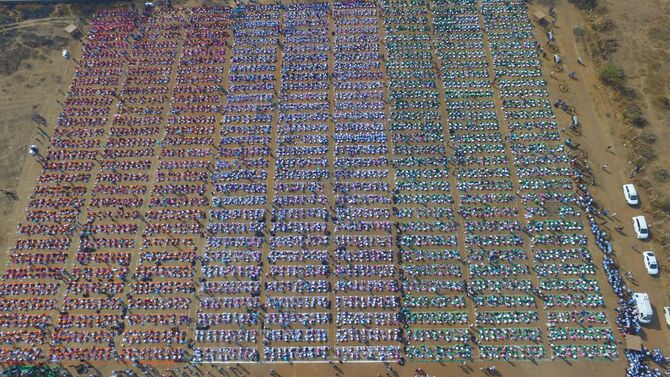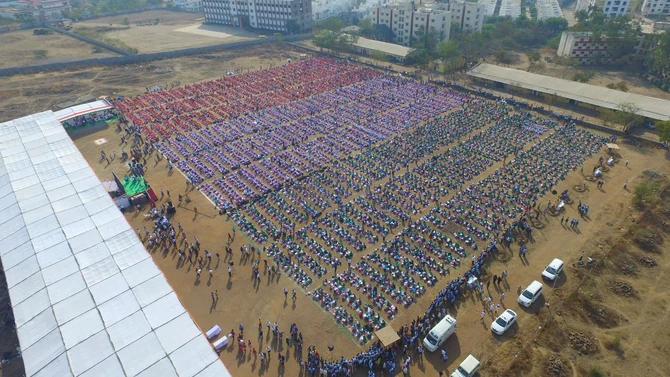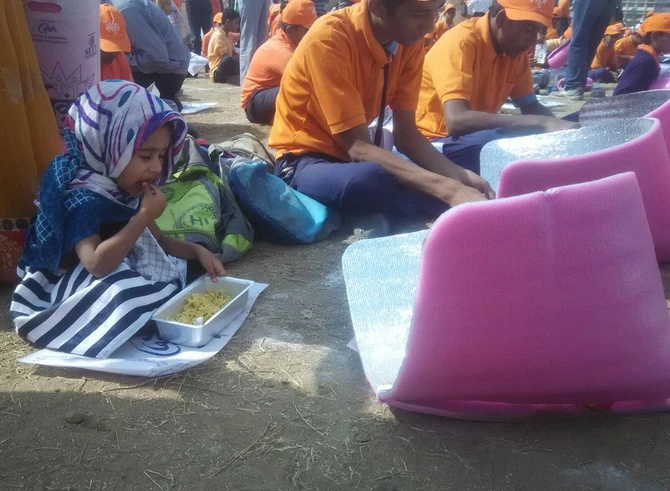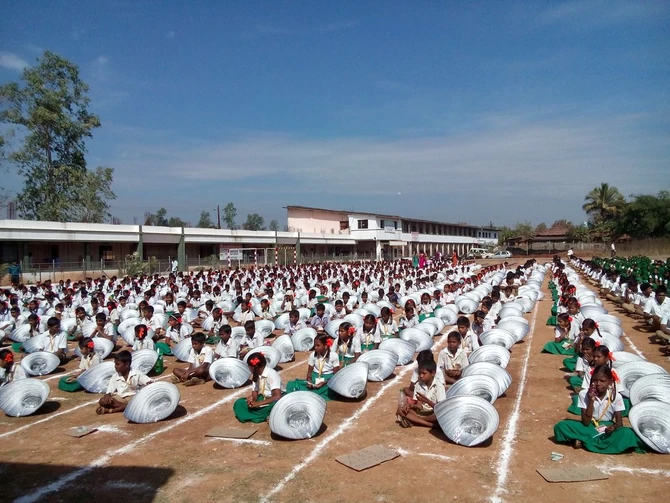|
Last edited: 20 July 2016
|
|
January 2016: World's largest solar cooking class takes place in India - On January 12, 2016, a total of 5,760 middle school students from over thirty schools gathered for Maha Suryakumbh organized by Keshav Srushti. Held at MIT College in Aurangabad, India, the students prepared a simple meal and learned to use a simple solar panel cooker. The event is up for accreditation by the Guinness Book of World Records. Ajay Chandak reports that included in the Indian government's five-year plan for 2012 through 2016, 30,000 million INR (approx. $600,000,000 USD) is budgeted for solar cooking instruction in 500,000 schools. |
Events
Featured international events
- 4-6 June 2024 (Bridgetown, Barbados): Sustainable Energy for All Global Forum - The event will be co-hosted by Sustainable Energy for All (SEforALL) and the government of Barbados. It is a platform for government, business and finance leaders, entrepreneurs, and youth and community representatives from around the world to come together to broker new partnerships, spur new investment, and address challenges at the nexus of energy, climate, and development. More information...
Online events
- NEW: Thursday, 18 April 2024 (2:30pm-3:15pm EDT), (Washington, D.C., USA): ESMAP Spring Meetings Knowledge Café: Clean Cooking at the Heart of Energy Access - Join ESMAP for this exciting knowledge-sharing opportunity, which will showcase the role of clean cooking as a key part of energy access and energy transition. Presentations by René van Hell, Director of Inclusive Growth, Ministry of Foreign Affair, Netherlands, Dr. Kandeh Yumkella Chairman, Presidential Initiative on Climate, Renewable Energy and Food Security, Sierra Leone, and Chandrasekar Govindarajalu, Practice Manager, ESMAP, World Bank. In-person attendance at World Bank Atrium, MC Front Lobby is for Spring Meetings registrants only. However, you can watch the event online
Requests for proposal
- Decentralized Renewable Energy Solutions utilizing Solar and Bio-Energy - Sustainable Energy Technologies and Assessments of ScienceDirect, is requesting guest-author submissions. The special issue, VSI: DRES is devoted to publishing research articles reporting the innovative designs and design interventions in solar thermal and bio-energy for decentralized energy systems (DES). It includes i) new and novel designs of prototype or commercial devices and technologies, their development, modeling and simulations and experimental validation; ii) innovations for processes, techniques, utilization, and applications; iii) novel use of materials for improving efficiency, performance, techno-economic feasibility, and sustainability and iv) research findings addressing the socio-economic, health and safety impacts, and life cycle assessments leading to proposing novel devices for DES. The Deadline for submission is 31 July 2024. More submittal information...
- See also: Global Calendar of Events and past events in India
Most significant projects
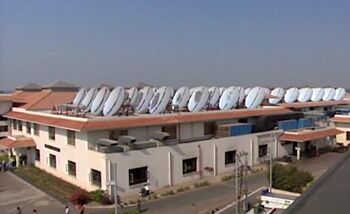
Shirdi roof collector array

Shirdi collector array diagram

Cooking in the kitchen at Shirdi
- Roof-top solar installation feeds 50,000 people per day: Gadhia Solar Energy Systems Pvt. Ltd. completed installation of an solar steam cooking system, capable of cooking 40,000-50,000 meals per day. It is located at Shirdi Saibaba temple in Shirdi, Maharashtra, India. With nearly 30,000 visitors each day, the temple’s dining halls are some of the largest in India. The solar steam cooking system is comprised of seventy-three rooftop-mounted Scheffler reflectors of sixteen square meters each. The dishes concentrate sunlight on receivers that contain water, generating steam that is piped down to the kitchen for cooking purposes. To maintain constant focus with the sun, the dishes automatically rotate throughout the day after being manually aligned once each morning. The solar steam cooking system is retrofitted to existing liquid petroleum gas-powered steam boilers that are still used in the evening and during prolonged periods of inclement weather. Though the solar steam cooking system cost nearly $300,000, government subsidies reduced the temple’s portion to about $170,000. Liquid petroleum gas use has been cut by roughly 100,000 kilograms each year, for an annual savings of approximately $45,000. The temple should recoup its investment in three to four years. According to company founder Deepak Gadhia, the solar steam cooking technology was originally developed in Germany. However, the equipment does not contain imported components and is manufactured with local machinery and labor, creating much-needed jobs. Gadhia has adapted the system for use in India, and has installed 50 such systems of varying sizes over the past two decades. The March edition of CNN’s Eco Solutions program highlights the Shirdi Saibaba temple solar steam cooking system.
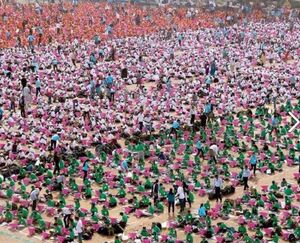
- World's largest solar cooking class takes place in India - On January 12, 2016, 5,760 middle school students from over thirty schools gathered for Maha Suryakumbh organized by Keshav Srushti. Held at MIT College in Aurangabad, India, the students prepared a simple meal and learned to use a simple solar panel cooker. The event is up for accreditation by the Guinness Book of World Records. Ajay Chandak reports that included in the Indian government's five-year plan for 2012 through 2016, 30,000 million INR (approx. $600,000,000USD) is budgeted for solar cooking instruction in 500,000 schools. Read more about the event...
News
- June 2016: "In order to promote solar thermal technologies to meet cooking energy requirements and to reduce dependence on traditional biomass and fossil fuels, the Ministry of New and Renewable Energy in the month of September 2014 sanctioned sale and distribution of 15000 Solar Cookers in three different phases at various locations in J&K at a tentative cost of Rs 1687.5 lakh. In the first phase, 5000 solar cookers were procured but only 2183 have been distributed till date despite the fact that target of 5000 was set on the basis of requisitions made by the district officers of the JAKEDA. Similarly, against target of 20000 biomass cookstoves only 3302 have been distributed by the JAKEDA."[1]
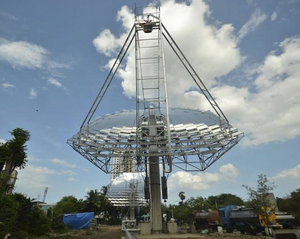
Aavin solar pasteurization array for milk processing - Photo credit: The Hindu
- June 2016: Aavin steps up production of with solar milk pasteurization - Aavin is the latest government agency to harness solar thermal energy for its daily operations in India. The hundreds of curved mirrors in two structures generate steam to pasteurize nearly one lakh(100,000) liters of milk a day. Read more...
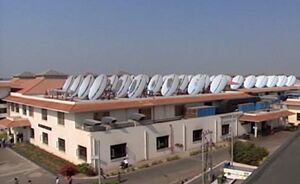
Shirdi roof collector array
- May 2016: Shirdi Temple wins solar thermal award - The Sai Prasadalaya, a community kitchen of Shri Saibaba Sansthan Shirdi has received the coveted Concentrated Solar Thermal (CST) and Solar Cooker Excellence Awards- 2016 by the ministry of new and renewable energy (MNRE). Shirdi Sai temple, which draws thousands of devotees every day, has one of world's largest Solar System Projects for community cooking installed in 2014. More information...
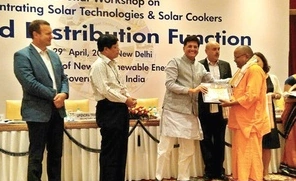
- May 2016: Solar thermal excellence award - Ramakrishna Mission Students’ Home in Chennai was recently conferred with an award for Concentrated Solar Thermal Excellence (CST) for their Solar Cooking System by MNRE, Government of India. The award was given for the school's installation of the ARUN 100 institutional solar steam generating and heat storage system. Award for excellence - NYOOOZ
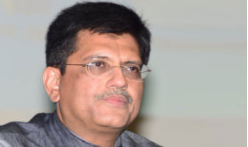
Piyush Goyal, Minister for State (Independent Charge) for Power, Coal and New & Renewable Energy - Photo: Saur Energy
- April 2016: India to lead in solar energy Piyush Goyal, Minister for State (Independent Charge) for Power, Coal and New & Renewable Energy, states India has exceeded solar targets by 116% this past year. Goyal said that India now will lead the world towards clean energy rather than follow. More Information...
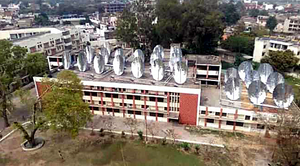
Steam generating solar array at Roorkee IIT saves 5,000LPG cylinders each year cooking student meals. Photo: The Tribune, India
- April 2016: The Institute of Technology in Roorkee has been using a solar installation to provide steam for student meal preparation for the past two years. They have saved the expense of as many as 5,000 LPG cylinders each year. Dean Dr Naveen Nawani said with the introduction of the solar steam cooking process, the quality of food has improved drastically. Read more...
- March 2016: BENGALURU: The Union Ministry of New and Renewable Energy (MNRE) has invited applications and proposals from educational institutions to convert to green campuses...Solar cooking systems must be utilised for hostels/hospitals etc. All houses, hostels and kitchens must have solar water heaters. Read more...
- January 2016: A record-setting 5,760 students participated in a solar cooking event on January 12, 2016 in Aurangabad as part of Maha Suryakumbh 2016 organized by Keshav Srushti. Read more... Video of event...
- January 2016: Keshav Srushti continues its extensive efforts to promote solar cooking in India. On January 24th, after this year's Maha SuryaKumbh, they will be opening an educational energy park in Uttan, a coastal town north of Mumbai. It will house an array of solar devices, including solar dryers and solar cookers. More information...
- August 2015: According to a Times of India news article, the city of Ludhiana will get a boost of solar power as the Union government has included the industrial capital of Punjab among 50 cities to be developed as solar cities. As part of this part of this project, solar cooking systems must be utilized for hostels/hospitals etc. Read more...
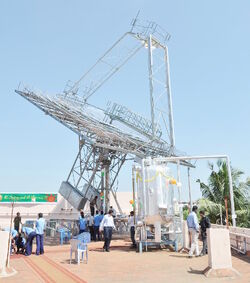
Solar energy concentrator at Ramakrishna Mission’s Students’ Home
- Investment brings large-scale solar cooking to Chennai school for orphans and underprivileged boys - Starting in 2013, a partnership between the UNDP, India's Ministry of New and Renewable Energy, and the Global Environment Facility, led to a project to install an ARUN®100 solar concentrator at the Ramakrishna Mission’s Students’ Home. The system provides enough energy to cook 3,000 meals per day and reduces LPG consumption by half, which leads to a savings of US$8,000 per year. Read more...
- March 2015: New solar cooking organization in India - On January 23, 2015 Solar Cookers India was formed. Dr. Mrs. Janak Palta McGilligan has graciously offered her services as the Honorary Executive Director of this new organization, which will work in close partnership with Solar Cookers International.

- March 2015: SCInet member wins national award - Janak McGilligan won the prestigious national Padmashri award for distinguished achievement in social service on January 26, 2015. The Padma Awards is one of the highest civilian awards given in India. As former Director and Founder of the Barli Development Institute for Rural Women, she pioneered solar parabolic cooking for community use.
- February 2015: India’s Ministry of New and Renewable Energy (MNRE) is inviting comments on its Draft Solar Policy - Sunday, March 1, 2015 will be the deadline for comments. The ten-page document, available here, outlines some of the government department’s thinking. “The Nodal Agency shall take necessary action to proliferate its application in feasible sectors including residential (solar water heaters, solar cookers, indoor air heating etc.), commercial & industrial sector (solar cooling, solar air dryers, large scale solar water heaters, large scale solar cooking utilizing solar concentrator technology, process heating etc.).” Read more...
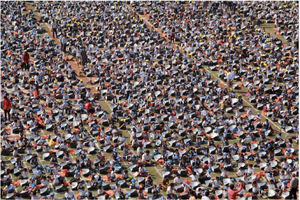
Thousands of students gather in Mumbai, India for a record-breaking solar cooking event.
- January 2015: 15,000 students in Mumbai solar cook and set world-record - 15,000 students from 80 schools in Mumbai, India set a new world-record for the largest ever solar cooking gathering organized by Keshav Srushti. Each student was given a solar cooker and taught how to use it as part of a national campaign to spread awareness of the importance of solar technology. C Vidyasagar Rao, governor of Maharashtra and Ashish Shelar, minister of state, Power, Coal & New Renewable Energy, attended the record-setting gathering. Read more at: Over 15,000 students create a new world-record in solar cooking
- January 2015: Annual Maha SuryaKumba reaches for a lofty goal - The Bhayander based NGO, Keshav Srushti, is committed to spreading awareness of solar cooking. Under the banner of Maha SuryaKumba, they will be gathering students from 500 schools across Mumbai in Bhayander,India, and then will be taking the festival to remote tribal villages. Hoping this year reach the magic number of 100,000 solar-powered prepared meals! Keshav Srushti has been accredited by the Guinness Book of World Records for having conducted the largest solar oven cooking class in January 2014 with 3,639 participants from 62 schools. The new goal of reaching so many students from remote areas will require financial support beyond the means of Keshav Srushti. Please contact Keshav Srushti If you can help, it will be appreciated. The NGO has announced there will now be an annual Maha SuryaKumba held on January 15th. More information...
History
- Main article: History of solar cooking in India
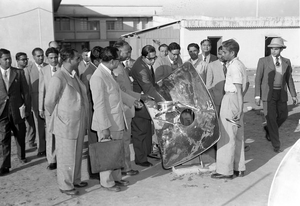
A solar cooking demonstration in Delhi in 1956. Photo credit: Wake-Up India
India, Asia's second largest country, next to China, has also the second largest number of solar cookers. The situation in India is more complex than that of China. More is also known about Indian programs. The Third World Conference on Solar Cooking was held in India, permitting the history and progress of solar the technology's uses to become better known around the world.
An official government report informs the reader that the Ministry of Non-Conventional Energy Sources (MNES), Government of India, was established in 1982, first as a Department and later as a Ministry. The Ministry's mandate extends well beyond solar cooking, including fuel efficient wood and charcoal stoves, power from other renewable sources, energy from industrial wastes, research and development in a number of related fields (photovoltaics, biogas, and pollution prevention, for example). MNES began seriously to promote solar cooking in the early 80s, with an initial focus almost entirely on the box cooker.
The population of India is roughly 70% rural. MNES states that "cooking accounts for a major share of the total energy consumption in rural homes (Singhal, correspondence, 2003, p. 1). Sources of that energy are largely fuelwood, animal dung, or crop residues, all of which emit smoke, pollute the atmosphere, and are deterimental to health and safety of family members, particularly women. Fuelwood is become scarcer each year. FAO data show that 21.6% of the Indian land mass is forested, and conservation efforts are in place to reverse previous loss. The effort is affected by the large and dense population and a slowing but still substantial birth rate (continuing to increase at 1.7% per annum, or 17% in a decade). Solar cooking has been viewed as one way to alleviate a number of India's problems and as such was supported by government efforts.
The Press Bureau of the Government of India reported in 2007 that there are 525,000 solar cookers installed in India.[1] The Press Bureau also reported in 2003 that, "The solar cooker programme has been expanded by introducing new designs for community use. Three solar steam cooking systems based on automatic tracking concentrating collective technology for cooking food for 600-3,000 people per day, and one system based on ‘Solar Bowl’ technology, have been installed. World's largest solar steam cooking system has been installed at Tirumala Tirupati. The system is designed to cook two meals for 15,000 persons in one day. Another system for 2,000 people was erected at Brahmakumaris Ashram in Gurgaon in July, 2002. Three community cookers for indoor cooking have been installed at a training hostel and an NGO’s establishment in Leh. In all, six such systems have been installed under the MNES demonstration scheme. A total of 500 dish solar cookers and 60 community solar cookers have been installed so far."[2]
- Main article: History of solar cooking
Archived articles
- Aga Khan Foundation
- Applied Science and Engineering
- C.K. Rohatgi
- C. Palaniappan
- Clique Solar
- Dinkar Verma
- EduCARE India
- Gadhia Solar Energy Systems
- Girja Sharan
- Haryana Renewable Energy Development Agency
- Jalpaiguri Akshay Rural Technology and Renewable Energy Entrepreneurship Development Centre
- Jimmy McGilligan
- Mathew SJ Muthuplackal
- Navratna Nahar
- Rohitas Electronics
- Sankha Subhra Datta
- Sathyavathi Muthu
- Shirin Gadhia
- Sol-Café
- Solar Health and Education Project
- Sun BD Corporation
- Sunil K. Somani
- Veerabhadran Ramanathan
- Veljibhai Desai
Climate and culture
Solar Cookers International has rated India as the #1 country worldwide for solar cooking potential. In the year 2020, the estimated number of people in India who will suffer from fuel scarcity is 157,400,000, but these people will continue to have ample access to the sun. In December 2007, the Indian Government instituted a program of rebates on various renewable energy devices including solar cookers. Solar cooking has even been recommended in the Rig Veda, a sacred Hindu text, stating: "All edibles ripened or cooked in the sun’s rays change into super medicine, the amrita."
 India Solar Resource Map provided by the National Renewable Energy Laboratory |
Fuels used for cooking
URBAN SECTOR
- LPG (47.96%)
- Firewood (22.74%)
- Kerosene (19.16%) and
- Other fuels (10.14)
RURAL SECTOR
- Firewood (64.10%)
- Other sources of biomass – crop residue (13.10%)
- Cow‐dung (12.80%)
- LPG (5.67%) is now increasing in importance. [2]
In a February 7th, 2015 article, The Economist reported that there are roughly 1 million deaths in India each year due to cooking fires[3].
Fuel subsidies
The Economic Times of India reports:
- While 300 million people live below poverty line, making do with energy inefficient dung cakes, twigs and branches, and occasional bits of coal, the urban middle class and the rural rich are splurging on cheap petrol and diesel and even cheaper kerosene and liquified petroleum gas.
- The subsidy is massive - hidden by a disingenuous device called oil bonds. Here are some rock solid facts. IOC, HPCL and BPCL are currently losing $137 million a day (i.e., Rs 582 crore per day at Rs 42.50 = $1). They lose Rs 16.34 for each litre of petrol, and Rs 23.49 for each litre of diesel sold in Delhi.
- The subsidy on kerosene at Rs 28.72 per litre is over three times the current retail price; and the subsidy on a cylinder of cooking gas at Rs 306 per cylinder exceeds the retail price. The total under-recovery for the oil marketing companies for 2006-07 was over $19 billion. With oil prices touching $135, under-recoveries can be $50 billion this year, unless retail prices are substantially increased.[4]
The Telegraph (UK) reported in September 2013 that, "Food and fuel subsidies are gobbling up much of the budget, while investment atrophies."[5]
Solar cooking already has a significant presense in India, especially with large scale projects, but the potential remains for its use to still significantly replace the use of conventioal fuels.
Cultural acceptance
In a report presented during the Asian Clean Energy Forum in June 2008, Soma Dutta, Asia Regional Network Coordinator for the Amsterdam-based ENERGIA International Network on Gender and Sustainable Energy, states that only 45% of India’s 70% rural population have access to electricity, and over 80 percent still rely on firewood as their primary cooking fuel, the gathering of which is a responsibility that almost always falls to the women and girls in a society. The long hours and significant effort spent simply gathering firewood leaves them little time for education or employment. [6]
Introductions of new technologies fail in villages for many reasons, but most commonly due to a lack of knowledge and understanding of local cultural customs. Solar cooking has often suffered this fate despite the purported cost savings because it is not introduced in a way that suited the lifestyles of the individuals using it.
A solar stove is most powerful at the times of the strongest sunlight, which is mid-day and early afternoon. As in many agricultural populations, village farmers in India consume their biggest meals by early to mid-morning and then again late at night, after the sun has set. In addition, certain solar stoves are not conducive to Indian-style cooking which is done mostly with oil (with the exception of rice) and requires frequent temperature manipulation as well as stirring and flipping which was is difficult with many solar cookers.[7]
While technical constraints limit the types of solar cookers likely to be widely adopted in India, there is historic precedent for solar cooking in Indian culture. A passage in ancient Vedic texts state, " Sun cooked food improves cellular health and longevity of life. It strengthens health and mind removes three major physical disorders to do with digestion, blood and respiratory system, balances inner body temperatures, life, glows aura and keeps various obstacles away. Sun cooked food has great medicinal value. It enhances intellect, genius." ' Rig Veda'. - Reference from the princeindia.org website. See: PRINCE
See also
- The climate of India - Wikipedia
- Enhancing the acceptance of solar cooking in India - Lt Col Dinkar Verma (Retd)
- June 2015: Women Spend 374 Hours Each Year Collecting Firewood in India, Study Finds - Global Alliance for Clean Cookstoves
- March 2015: Will mini-micro solar remain a toy for the middle-class and rich in India? - Moneylife
- Explaining the Unexpectedly Low Use of Solar Cookers in Gujarat, India - Girja Sharan and Raju Pandya
- July 2006: Integrated Approach for Promoting Solar Cookers in Rural Areas of Tamil Nadu - Dr. Sathyavathi Muthu and Ms. G. Anuradha
- July 2006: Dissemination of Solar Cooker Information - Mamata Dutta
- July 2006: Sustainable Energy Policies for Promotion of Solar Cookers in India - Sudha Mahalingam
- An Analysis of Solar Cooker Usage - Bashir Ahmad
- Solar cooker dissemination and cultural variables
Resources
Blogs
Possible funders
- GEF Small Grants Programme
- See also general guidance on raising funds through grants and donations
Photographs
Reports
- April 2016: Deepak Gadhia CONSOLFOOD 2016 presentation - Evolution of Solar Concentrating Technologies in India, from the domestic community to institutional cooking. New solar concentrator technologies to expand its usage for the food processing industry (process heating, cooling, drying, etc) - Deepak Gadhia, Chief Mentor, EnerSun Power Tech P. Ltd & Trustee of Muni Seva Ashram, India
- June 2015: Women Spend 374 Hours Each Year Collecting Firewood in India, Study Finds - Global Alliance for Clean Cookstoves
- August 2014: ARUN®100 Installation at Akshardham Temple, New Delhi - Ajay Chandak
- August 2014: ARUN®100 with Thermal Storage at Ramkrishna Mission, Chennai - Ajay Chandak
- June 2014: A (new) cultural turn toward solar cooking—Evidence from six case studies across India and Burkina Faso - Pia Otte
- November 2012: Explaining the Unexpectedly Low Use of Solar Cookers in Gujarat, India - Girja Sharan and Raju Pandya
- November 2012: Bashir Ahmad, a Research Fellow at the Technical University of Denmark, provides an analysis of solar cooker usage compared to conventional cooking methods. Data was collected for the study in India and Burkina Faso in the 80's and 90's. An Analysis of Solar Cooker Usage - Bashir Ahmad
- February 2012: Patricia McArdle attended a workshop dealing with the construction and proper alignment techniques for Scheffler Community Kitchens in Dhule, India: Read her report.
- Spring 2009: Solar Box Cooker for Gujarat, India - Ashok Gadgil
- January 2009: Watermelon Processing in Integrated Solar Heater, Cooker, and Dryer - P.C. Pande
- January 2009: Thematic Studies for Processing and Preservation of Foods with Solar Energy - Ranjita Bezbaruah Sharma
- January 2009: Fortification of Solar Dried Fruit Bars -G. Sarojini, V. Veena, M. Ramakrishna Rao
- January 2009: Perspectives of Solar Food Processing in India - C. Palaniappan
- January 2009: Micro-Enterprises in Solar Food Processing - M. Ramakrishna Rao, D.J. Rao, S.L. Kumar
- January 2009: Food Processing Through Solar Energy - Ghanshyam Lukhi
- January 2009: Promotion of SK14 Solar Cookers through an Eco Center- Case Study of a Unique North-South Co-operation - Dr. Shirin Gadhia
- January 2009: Promotion of Smoke Free Villages in Chittoor District & Employment Generation to Rural Youth - Jagadeeswara Reddy
- January 2009: Advancing towards achievement of Millennium Development Goals by training Rural and Tribal women in Solar Food Processing - A Hands-on Experience at Barli Development Institute for Rural Women in Central India - Dr. Janak Palta McGilligan
- August 2008: A Solar Cooking Day
- July 2006: Disseminsation of Solar Cooker Information - Mamata Dutta
- July 2006: Sustainable Energy Policies for Promotion of Solar Cookers in India - Sudha Mahalingam
- March 2003: India's solar cooker program - Solar Cooker Review
- June 2001 S. Narayanaswamy Sheds Light on Solar Cooking - India Together
- May 1999: Solar Cooking Technology - How Far are Technology Promoters and Users From Each Other?
Articles in the media
- July 2016: NGO organizes solar cooker workshop for students - Times of India
- June 2016: India: Government Presents 102 Awards for Solar Process Heat and Solar Cooking - Global Solar Thermal Energy Council
- May 2016: Waiting to exhale - The Hindu
- May 2016: Ministry selected Aryans Chandigarh for developing as Green Campus - Punjab News Express
- May 2016: India air pollution kills half a million per year, costs hundreds of billions – study - RT
- May 2016: Making xacuti while the sun shines - Times of India
- May 2016: GEDA’s solar cooker initiative wins laurels - Times of India
- April 2016: McGilligan demonstrates power of solar cooking - The Free Press Journal
- April 2016: Roorkee IIT uses solar energy for steam cooking - The Tribune
- March 2016: When summer arrives, go solar - The Navhind Times
- March 2016: BIT Ras Al Khaimah Campus honoured - Khaleej Times
- February 2016: A culinary date with the sun on Sankranti - Indian Voice
- January 2016: Particular about particulates - The Economist
- January 2016: Solar oven building workshop for women - The Times of India
- December 2015: India's Solar Initiative and the Challenge of Climate-Safe Development - Living on Earth
- December 2015: This solar cooker will work at night too - The Times of India
- December 2015: IISc scientists develop solar cooking device - Deccan Herald
- December 2015: Almora school leads by example, cooks midday meal using solar cookers - The Times of India
- December 2015: Students all set to make PAU campus eco-friendly - The Tribune
- November 2015: One in three Indians in 2040 will depend on firewood for cooking - The Economic Times
- October 2015: NTPC installs solar thermal cooking system at Dadri power plant - The Hindu BusinessLine
- September 2015: Neeri develops more efficient solar tech - The Times of India
- August 2015: Solar power thrust for Ludhiana - The Times of India
- April 2015: India: PRINCE Offers Solar Cooking Workshops for New Entrepreneurs - Global Solar Thermal Energy Council
- March 2015: Will mini-micro solar remain a toy for the middle-class and rich in India? - Moneylife
- March 2015: Fair Glow in Solar Energy - The Telegraph
- February 2015: Pollution in India and China: Indian winter - The Economist
- January 2015: Children to learn about clean solar cookers on festival day - gulfnews.com
- January 2015: Healthy food via solar cooker - Moneylife
- August 2014: Keshav Srushti opens ‘Maha Suryakumbh’ - The FREE PRESS Journal
- February 2014: Sun Smiles on a Cold Desert - Independent European Daily Express
- November 2013: More Indian schools to get solar cookers - The Hindu
- August 2013: Solar cooking technology - The Hindu
- June 2013: Go solar for healthier food' - The Times of India
- April 2013: Vintage Visakha organized a demonstration of solar cooking at its office at Abidnagar. Solar cooking demo held - The Hindu
- March 2013: Solar City on the beam - The New Indian Express
- November 2012: Sun fuels hearth at Akshardham - The Times of India
- August 2012: INDIA’s FIRST & UNIQUE “GREEN ASHRAM” at the Solar Capital of India GUJARAT – A model & multiplier for Renewable energy and Sustainable Community - urvishdave
- October 2012: Major Indian pilgrimage centres going green - AAJKI KABAR
- June 2012: Gujarat septuagenarian taps solar power - Daily News and Analysis
- June 2012: Ambaji temple goes green - The Times of India
- April 2012: Soon, Golden Temple may dish out solar-cooked langar - The Indian Express
- February 2012: Medical colleges into green mode for change - The Pioneer
- February 2012: Farooq for encouraging renewable energy sources - IBN Live
- December 2011: Plan to reap benefits of solar cooking system - The Hindu
- June 2011: Shirdi’s Prasadalaya achieves a first, using solar energy to make meals for devotees - Daily India.com
- May 2011: Gurgaon goes green - Hindustan Times
- August 2010: Sierra Club Helps Bring Green Jobs to India - The Bay Citizen
- July 2010: Renewal Energy Park in India Set to Open During October 2010 - A to Z Cleantech
- June 2010: Smoke-free solar cooker cooks up interest in this tiny hamlet - The Times of India
- November 2009: "Every [Indian] individual/household should have a solar cooker," says Arvind Virmani, Chief Economic Advisor, Ministry of Finance, Government of India.
- October 2009: Mass-market U.N. carbon scheme finds favor in India - Reuters
- July 2009: Economic Survey urges Indian Government to eliminate cooking fuel/kerosene subsidies and ensure rural households have a solar cooker and a solar lantern - The Hindu, Business Times
- July 2009: Solar energy to cook 30k meals at university - The Times of India
- February 2008: Bharat hot on solar cookers, new energy - The Times of India
- February 2008: Yes They Could, So They Did - New York Times
- July 2008: India's Temples Go Green - Time Magazine
- June 2008: India tackles climate change with renewable energy - The Guardian (UK)
- June 2008: Cooking with the sun - The Hindu
- June 2008: Kitchen for poor kids go high-tech (solar) in state homes - Express India
- June 2008: Gujarat industry opposed fuel price hikes - Thaindian News
- March 2008: Rewriting the Books in Ladakh - Cultural Survival Quarterly
- March 2008: Black carbon pollution emerges as major player in global warming - Scripps Institution of Oceanography
- February 2008: Fiscal policy to act as a tool to lighten the oil shock - The Economic Times
- February 2008: Govt looking for consultants to tap CDM benefits - The Economic Times
- January 2008: Everything under the sun - The Times of India
- July 2007: Holy smoke! Religious places too earning carbon credits - The Times of India
- April 2007: UN engages banks to light up rural India; Solar loans, energy access transform life for poor - EurekAlert
- March 2007: Solar cookers save Indian emissions - NDTV.com
Audio and video
- May 2016:
- January 2016:
- June 2015:
- February 2015:
- July 2014:
- January 2014:
- December 2013:
- May 2013:
- February 2010:
- February 2010:
Solar Cookers in India, Global Ideas
Deepak Gadhia's efforts promoting various solar powered projects
- September 2007:
Contacts
The entities listed below are either based in India, or have established solar cooking projects there:
SCI Associates
- Ajay Chandak
- Alzubair Saiyed
- Deepak Gadhia
- Foundation for Sustainable Technologies
- International Center for Networking, Ecology, Education and Re-Integration
- Janak McGilligan
- Jimmy McGilligan Centre for Sustainable Development
- Kinarkumar Patel
- Orjabox
- Promoters, Researchers and Innovators in New and Clean Energy
- Solar Cookers India
- Sun BD Corporation
- TinyTech Plants
- Main article: Solar Cookers International Association
NGOs
- 100 Suns
- Aga Khan Foundation
- Auroville Solar Kitchen
- Barli Development Institute for Rural Women
- Brahma Kumaris
- Climate Healers
- Foundation for Sustainable Technologies
- Friendly Appropriate Solar Technologies
- International Center for Networking, Ecology, Education and Re-Integration
- International Institute for Applied Systems Analysis
- Jimmy McGilligan Centre for Sustainable Development
- Keshav Srushti
- Lady Fatemah Trust
- Malaviya Solar Energy Consultancy
- Naandi Foundation
- Promoters, Researchers and Innovators in New and Clean Energy
- SELCO Foundation
- Simplified Technologies for Life
- Solar Alternatives and Associated Programmes
- Solar Cookers India
- Solar Cooking Campaign for Grassroots
- Solare Brücke
- Solare Zukunft
- The Energy and Resources Institute
- Tirumala Tirupati Devasthanam
- Uttarakhand Renewable Development Agency
- WISIONS of Sustainability
- Women Barefoot Solar Cooker Engineers Society
Manufacturers and vendors
- DayStar Solar Cooking Solutions
- Ecoo
- EnKing International
- FUTEK
- Fair Fabricators
- Foundation for Sustainable Technologies
- Indiamart
- Kivu
- Malaviya Solar Energy Consultancy
- Manik Solar Innovation
- Orjabox
- Promoters, Researchers and Innovators in New and Clean Energy
- Radha Energy Cell
- Ravindra Pardeshi
- Redsun Solar Industries
- Rudra Solar Energy
- SOLA Solar Cooker 1
- Simply Solar
- Solar India
- Su Solartech Systems
- SunVenture
- Sun Oven India
- Sundish
- Sunrise CSP
- Tapi Food Products
- TinyTech Plants
- UNesar Private Limited
Individuals
Government agencies
Educational institutions
See also
- 6th SCI World Conference 2017
- ARUN 100
- Category:Andhra Pradesh
- Category:Arunachal Pradesh
- Category:Assam
- Balcony Solar Cooker
- Bamboo Solar Cooker
- Category:Bihar
- Category:Chhattisgarh
- Community Solar Cooker 10 SQ MT
- Category:Delhi
- Domestic Parabolic Solar Cooker
- Category:Goa
- Category:Guirat
- Category:Gujarat
- Category:Haryana
- Category:Himachal Pradesh
- History of solar cooking in India
- India news archive
- International Solar Food Processing Conference 2009
- Category:Jammu and Kashmir
- Category:Jharkhand
- Category:Karnataka
- Category:Kerala
- Low-cost Tile Box Cooker
- Low-cost Wooden Solar Box Cooker
- Category:Madhya Pradesh
- Category:Maharashtra
- Making the Most of Sunshine
- Manik Parabolic Cooker
- Manik Trough Cooker
- Category:Manipur
- Category:Meghalaya
- Category:Mizoram
- Category:Nagaland
- Category:National Capital Territory of Delhi
- Category:Odisha
- Category:Orissa
- PRINCE-40
- Parabolic solar concentrator for industrial heating
- Category:Punjab
- Category:Rajasthan
- Saracon
- Category:Sikkim
- Smoke-Free Village
- SolaCooka
- Solar-roasted peanut butter plant
- States of India
- Category:Tamil Nadu
- Category:Telangana
- Category:Tripura
- Universal Engineers Enterprise
- Category:Uttar Pradesh
- Category:Uttarakhand
- Category:West Bengal
References
- ↑ http://www.dailyexcelsior.com/govt-fails-to-provide-benefits-of-rs-45-cr-worth-schemes-of-mnre-to-people/
- ↑ http://static2.wikia.nocookie.net/__cb20090624234723/solarcooking/images/8/8f/Performance_analysis_Solar_Parabolic_concentrator_for_cooking_applications_P._Rajamohan%2C_S._Shanmugan%2C_K._Ramanathan%2C_D._Mutharasu_%28January_2009%29.pdf
- ↑ http://www.economist.com/news/leaders/21642172-narendra-modi-should-learn-chinas-mistakes-its-too-late-indian-winter?fsrc=scn/fb/te/pe/ed/indianwinter
- ↑ http://economictimes.indiatimes.com/Debate/How_to_deal_with_ever-rising_crude_prices/articleshow/3094985.cms
- ↑ http://www.telegraph.co.uk/finance/currency/10277392/India-pushes-shock-and-awe-currency-plan-to-save-BRICS.html
- ↑ http://www.ipsnews.net/news.asp?idnews=42725
- ↑ http://www.travelblog.org/Asia/India/Andhra-Pradesh/Hyderabad/blog-449965.html4




